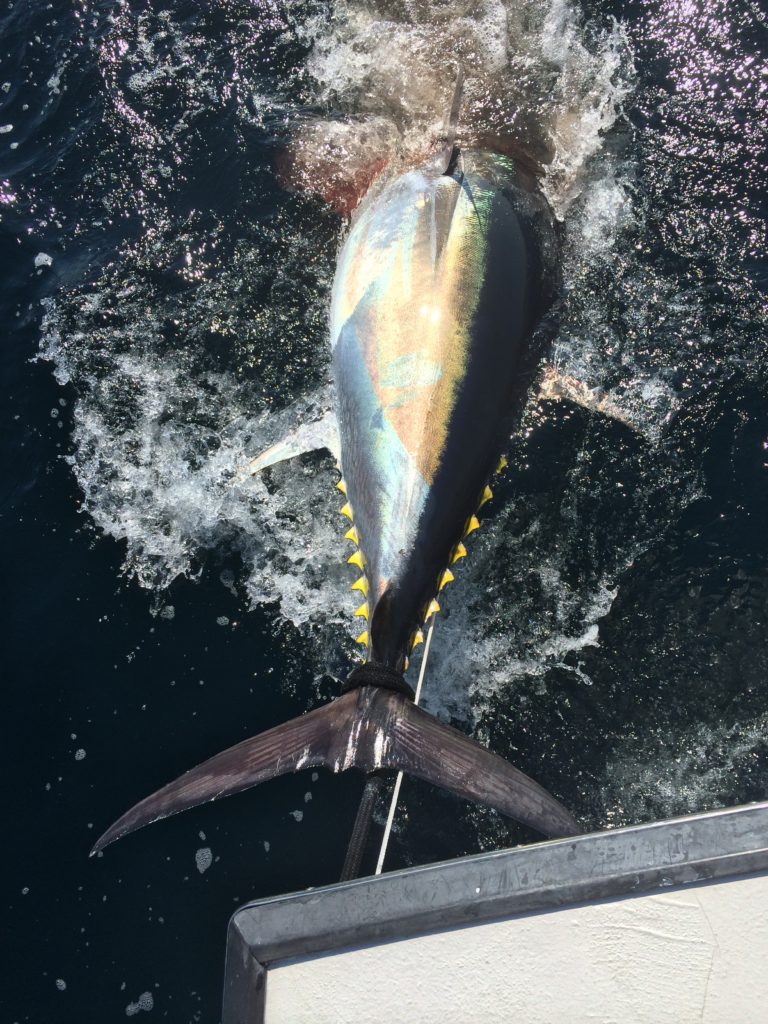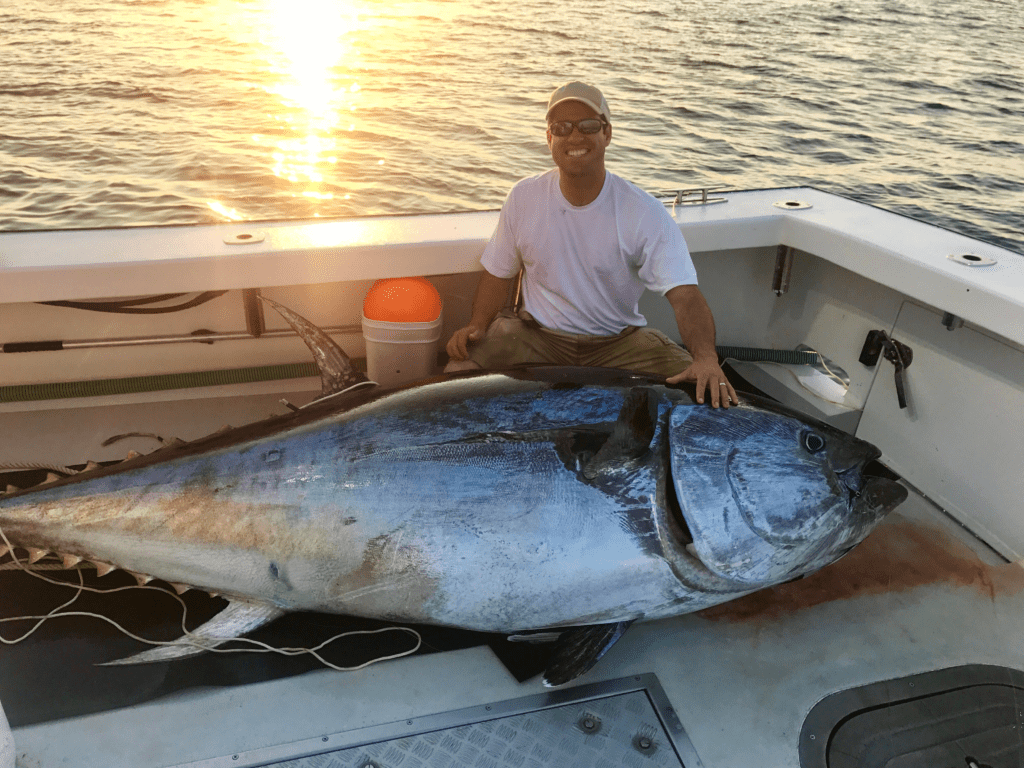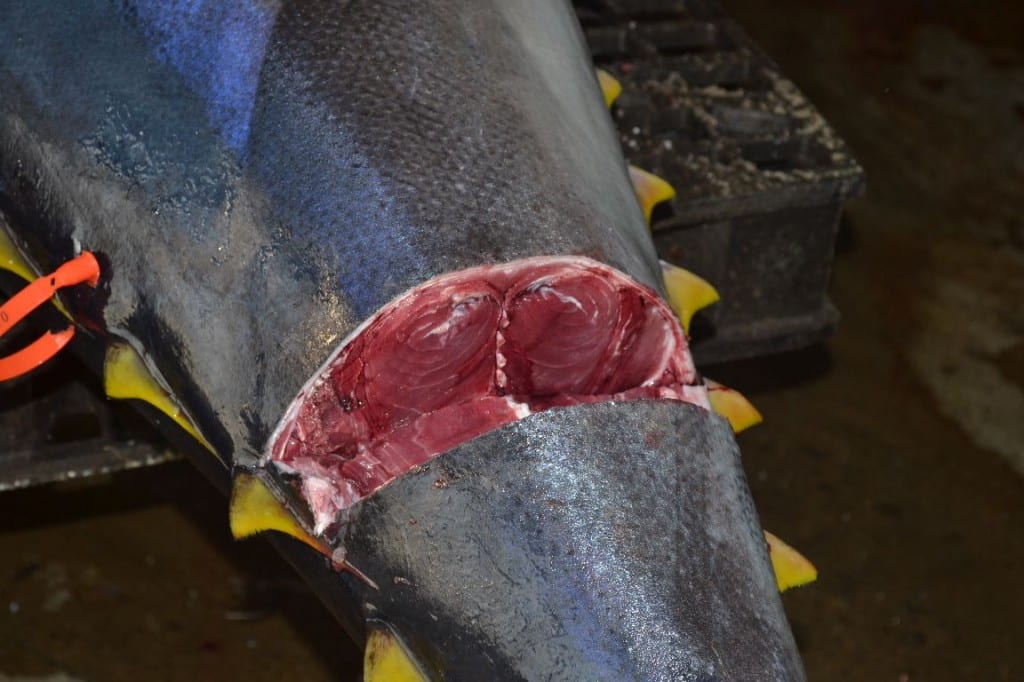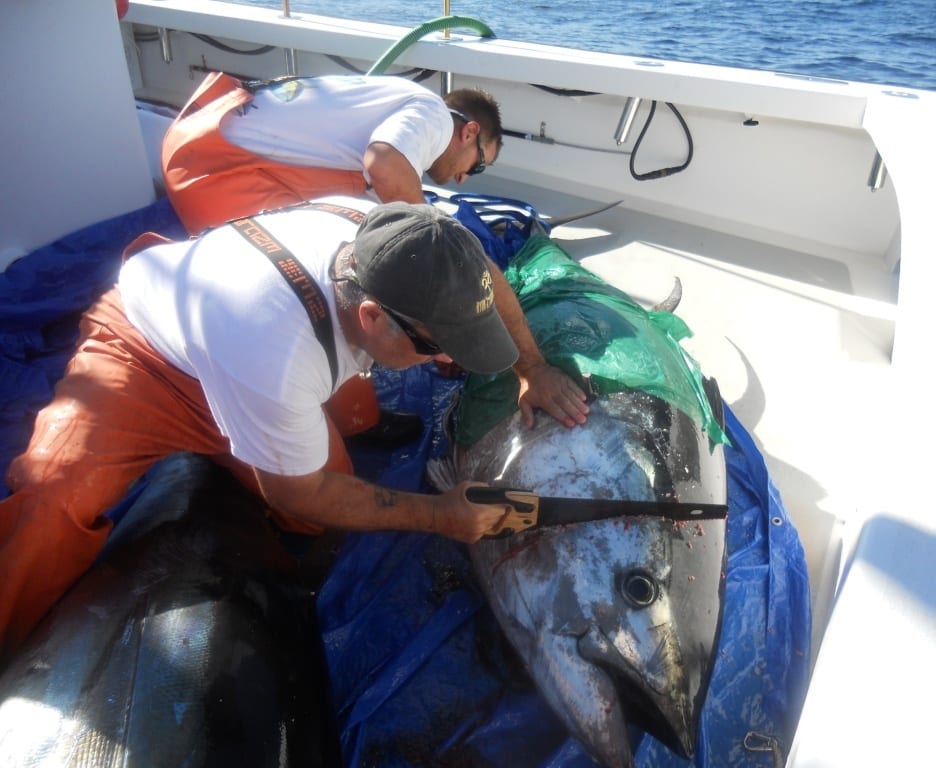Bluefin Tuna Fishing Gloucester, MA Karen Lynn Charters
I have been asked in person and on the marine radio by others about how to best kill, care, and handle Blue Fin Tuna. I thought it might be helpful to some of the newer Bluefin Tuna fisherman on this site to post how we try to do it. This is by no means the “only” or “correct” way, it is simply one method and the way we were taught in the commercial Bluefin Tuna fishery where the difference in caring for the catch in the first 30 minutes, can be worth thousands of dollars. The same routine is used on all of our Bluefin Tuna fishing charters. I hope it is helpful.
Bluefin Tuna Part 1
Part 1. Killing and bleeding the fish This sounds simple and obvious but how you kill a Bluefin tuna greatly affects the quality of the meat. With fish that are in the 47″-73″ size range, we will usually bring them to the boat and leader and gaff them in the head area. I know it can be scary but try to wait and don’t try too gaff them to early and then get them swimming along the boat at 1-2 knot speed. They will often lie on their sides, exhausted and present a very easy target.
Immediately after gaffing the tuna we will slip a tail rope over the tail using a second gaff to hold or pick up the tail. We will then cut the leader or remove the hook, and sink a head hook through the lower jaw and starting swimming the fish from it’s head behind the boat, slowly 2-3 knots, secured by the head hook and keeping the tail rope on the fish and cleated off. But not so tight that the tuna can’t swim somewhat naturally. We will try to swim the fish for 10-20 minutes. Until it seems to have really come back to life and gets some of it’s natural vibrant color back.
Bluefin Tuna Fishing Gloucester, MA
Always Gaff through the head and never in the throat where the heart is located or it will bleed out while you are swimming it. We will then pull it back to the boat by the tail rope and bleed it out. NOTE: We have found that on the 50″-60″ fish that instead of using the rubber coated wire and carabiner tail ropes we use for giants, that a 3/8″ nylon braid dock line with a spliced eye loop gives us a more secure grip on the smaller tail of these fish. First we will pull the fish up high on the transom by it’s tail rope and make a cut approximately 2″ wide and 1″ deep behind one or both pectoral fins which taps into major arteries. We used to also make a bleed cut on the tail but found it wasn’t necessary and cutting too deeply, makes real problems.
Then towing the Bluefin Tuna by it’s tail, we will rake it’s gills with a gaff or more preferably a harpoon iron while towing it. This should fairly quickly bleed out the fish. Once the blood flow slows down and the fish does not appear to have much movement, we haul it onto the deck by the tail rope and take some very quick pictures with the anglers then immediately start to dress it. Leaving the fish on the deck in the sun for even 15-20 minutes can really shorten the refrigerated shelf life of tuna steaks. High Core temperature of the fish is your enemy and you want to get it cooled down as quickly as possible.
Bluefin Tuna Part 2
Part 2. Dressing the fish With the fish on the deck, we use a basic short handsaw (Stanley 15″ Fat Max, $16 @ Home Depot) to cut off the head of the fish. I would suggest that if you are new to this you do this in a few cuts versus just lopping the head off which could case you to lose good meat. See the drawing below.
Next you want to carefully cut in a circle around the fishes anus so you can pull the main intestine out of the body and carefully cut it free. This allows you to remove from the head cavity, the stomach, organs, etc… in one shot. After you get all these parts out we wash out the cavity with a high volume, salt water wash down. You can also scrub the cavity with a stiff round boat brush with a 2′ handle to get rid of any coagulated blood. Don’t forget to cut open the stomach to see what the tuna was feeding on before throwing it overboard. You can also remove fins, except one pectoral fin and the tail for easier handling.
Bluefin Tuna Part 3
Part 3. Icing and Storing the Bluefin Tuna. We cram the body cavity with as much crushed ice as we can carefully packing it in. Next we place the carcass in a bed of ice in a 4′ cooler and pack it as tightly as we can with ice around it and fill the cooler. The heat from the fish will quickly melt out the ice around it. So packing the cooler with lots of ice to the brim helps to not have warm air pockets around the fish. We then put the cooler in our below deck fish hold or in our big, on deck ice box to help keep it cold and to keep the sun off of it.
For those of you in smaller boats consider putting it under the T top. Another great alternative is an insulated bag. We recently bought a good tuna bag for Giant Bluefin Tuna. We also used the bag when a scientist on a Bluefin tuna fishing charter on the Karen Lynn was sampling other boat’s catch, to help with a study for the Large Pelagic Research Lab. And the bag was incredible in keeping ice and cooling down multiple fish before we gave them back.
This all may seem a bit obsessive and extreme. But try it once and you will be amazed at the quality of the fish you are grilling that night! After you have done this procedure a few times it is easy and goes very quickly; for our crew it is almost automatic. As I said before, this is just one way to do it and there are always good alternative ways and improvements. Good luck out there tuna fishing! Thanks!
Captain Collin MacKenzie
Karen Lynn Charters






